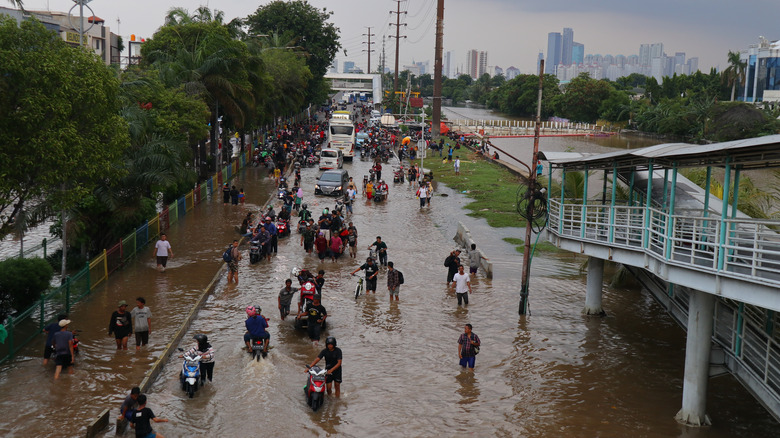Why Coastal Cities Are In Bigger Danger Than You Thought
Scientists have repeatedly warned about the threat posed by rising sea levels, which is the topic of a new study published in Geophysical Research Letters. According to the research, coastal cities across continents are sinking at a rather brisk pace, further aggravating the risks of a mass exodus and infrastructure damage in the relatively near future. Using satellite data, scientists studied the subsidence rate of 99 coastal cities across six continents and observed that the speed at which these cities are sinking is faster than the pace at which sea levels are rising.
The concept of land subsidence is easy to understand: it happens when subsurface Earth materials are displaced or removed, causing the top surface to sink, either gradually or suddenly, as explained by the USGS. Indiscriminate extraction of water and mining activities are some of the key reasons behind land subsidence.
As part of the latest research, a team measured the subsidence happening across these 99 cities between 2015 and 2020 and found that cities in Asia are at the highest risk. Rapid land subsidence was also observed in coastal cities across Africa, Australia, Europe, and North America. Tianjin, Semarang, and Jakarta recorded the worst sinking rate of just under 1.2 inches per year, which is 15 times higher than the rate at which the global mean sea level is rising. Per a BBC report, Jakarta is the fastest sinking city in the world. With a combined population of more than 59 million people, Chittagong in Bangladesh, Tianjin in China, Manila in the Philippines, and Pakistan's Karachi are among the worst-hit cities with the highest risk attached to them.
A one-two threat for coastal cities
One-third of the cities observed as part of this study recorded a subsidence rate of more than 0.4 inches per year, which is quite a concerning stat. Notably, high subsidence has been observed in both industrial and residential areas. Unregulated groundwater extraction is a recurring theme in almost all the at-risk cities, requiring urgent government intervention with proper policies to avoid the dire consequences if the problematic trend continues.
The double whammy of rising sea levels and an even faster rate of land subsidence only accelerates the risk of habitable land sinking sooner than what current climate change models predict. As per data compiled by NOAA and shared via Climate.gov, the global sea level reached a new record high of 3.6 inches in 2020, and the rate at which the sea level is rising is only accelerating. According to the World Economic Forum, Dhaka, Lagos, and Nigeria could have vast tracts of land submerged underwater by the yea 2100 if the rising sea level trend and land subsidence continues.
Fortunately, not all is lost. With controlled groundwater extraction that was mandated by government regulations, cities like Jakarta and Shanghai managed to dramatically slow down the rate at which these cities were sinking. However, certain areas in these cities that are closer to the sea are still recording a subsidence rate of 0.4 to 2 inches per year based on line of sight (LOS) observations.

